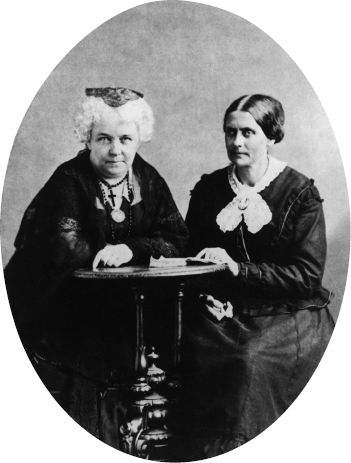The Fifteenth Amendment and Women’s Demands
Printed Page 469

In February 1869, Republicans passed the Fifteenth Amendment to the Constitution, which prohibited states from depriving any citizen of the right to vote because of “race, color, or previous condition of servitude.” The Reconstruction Acts of 1867 already required black suffrage in the South; the Fifteenth Amendment extended black voting nationwide.
 Constitutional amendment passed in February 1869 prohibiting states from depriving any citizen of the right to vote because of “race, color, or previous condition of servitude.” It extended black suffrage nationwide. Woman suffrage advocates were disappointed that the amendment failed to extend voting rights to women.
Constitutional amendment passed in February 1869 prohibiting states from depriving any citizen of the right to vote because of “race, color, or previous condition of servitude.” It extended black suffrage nationwide. Woman suffrage advocates were disappointed that the amendment failed to extend voting rights to women.
Some Republicans, however, found the final wording of the Fifteenth Amendment “lame and halting.” Rather than absolutely guaranteeing the right to vote, the amendment merely prohibited exclusion on grounds of race. The distinction would prove to be significant. In time, white Southerners would devise tests of literacy and property and other apparently nonracial measures that would effectively disfranchise blacks yet not violate the Fifteenth Amendment. But an amendment that fully guaranteed the right to vote courted defeat outside the South. Rising antiforeign sentiment — against the Chinese in California and European immigrants in the Northeast — caused states to resist giving up total control of suffrage requirements. In March 1870, after three-fourths of the states had ratified it, the Fifteenth Amendment became part of the Constitution.
CHAPTER LOCATOR
Why did Congress object to Lincoln’s wartime plan for reconstruction?
How did the North respond to the passage of black codes in the southern states?
How radical was congressional reconstruction?
What brought the elements of the South’s Republican coalition together?
Why did reconstruction collapse?
Conclusion: Was reconstruction “a revolution but half accomplished”?
 LearningCurve
LearningCurve
Check what you know.
Woman suffrage advocates, however, were sorely disappointed with the Fifteenth Amendment’s failure to extend voting rights to women. Elizabeth Cady Stanton and Susan B. Anthony condemned the Republicans’ “negro first” strategy and pointed out that women remained “the only class of citizens wholly unrepresented in the government.” The Fifteenth Amendment severed the early feminist movement from its abolitionist roots. Over the next several decades, feminists established an independent suffrage crusade that drew millions of women into political life.
Republicans took enough satisfaction in the Fifteenth Amendment to promptly scratch the “Negro question” from the agenda of national politics. Even Wendell Phillips, a steadfast crusader for equality, concluded that the black man now held “sufficient shield in his own hands. … Whatever he suffers will be largely now, and in future, his own fault.” Northerners had no idea of the violent struggles that lay ahead.
QUICK REVIEW
Question
Why did Congress impeach President Andrew Johnson?